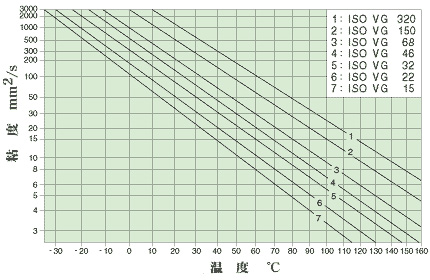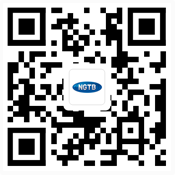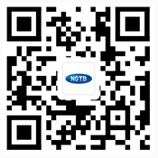Inspection when machine is Running
- Categories:技术支持
- Time of issue:2021-02-04 11:02:30
- Views:0
1.Bearing Temperature
Bearing temperature generally rises with start-up and stabilizes at a temperature slightly lower than at start-up (normally 10 to 40 °C higher than room temperature) in a certain time. The time before stabilizing depends on the size, type, speed, and lubrication system of the bearing and the heat dissipation condition around the bearing. It ranges from about 20 minutes to as long as several hours.
If bearing temperature does not stabilize but continues to rise, the causes shown in following are conceivable Operation should be stopped and an appropriate corrective action should be taken.
High bearing temperature is not desirable in view of maintaining an adequate service life and preventing lubricant deterioration. A desirable bearing temperature is generally below 100 °C.
Major causes of high bearing temperature
1.Extremely insufficient or excessive lubricant
2.Poor installation of the bearings
3.Extremely small bearing clearance or extremely heavy load
4.Extremely high friction between lip and seal groove
5.Improper lubricant type
6.Creep between the fitting surfaces
2.Operating Sound of Bearing
The following table lists typical abnormal bearing sounds and their causes. Please note that the description of some of these sounds is rather subjective and thus could vary considerably from person to person.
Typical Abnormal Bearing Sounds and Their Causes。
| Sound | Features | Causes |
| Hiss | Small bearings | Raceway, ball or roller surfaces are rough. |
| Buzz to Roar | Loudness and pitch change with speed. | Resonation Poor fit (Poor shaft shape) Bearing rings deformed. Vibration of raceways, balls, or rollers (For large bearings, if this sound is minor, then this is considered normal). Brinelling |
| Crunch | Felt when the bearing is rotated by hand. | Scoring of raceway surface (regular). Scoring of balls or rollers (irregular). Dust/Contamination Deformed bearing ring (partial interference clearance). |
| Hum | Disappears when power supply is switched off. | Electromagnetic sound of motor. |
| Chatter | Noticeable at low speeds. Continuous at high speeds. |
Bumping in cage pockets (insufficient lubricant) --eliminated by clearance reduction or pre-loading. Rollers bumping into each other on full-roller bearing. |
| Clang/Clatter | Metallic, loud bumping sound. Thin section large bearing (TTB) at low speeds. |
Bearing ring deformed. Grating of key. |
| Screech/Howl | Occurs mainly on cylindrical roller bearings. Sound changes with speed. Loud metallic sound that disappears temporarily when grease is added. |
Large radial clearance. Poor lubrication/grease consistancy. |
| Squeak | Metal-to-metal spalling sound. High pitch |
Spalling of roller and rib of roller bearing. Small clearance Poor lubrication |
| Squeal | Generated irregularly due to grating. | Slip on fitting surfaces. Grating on mounting seat, of key, etc. |
| Faint tinkle | Irregular (not changing with speed). Primarily on small bearings. |
Dust in bearing. |
| Rustle | Sound quality remains the same even if speed changes (Dirt). Sound quality changes with speed (Scoring). |
Dirt Raceway, ball, or roller surfaces are rough. |
| Rustle | Generated intermittently at regular intervals. | Chafing at the labyrinth. Contact of cage and seal. |
| Rustle patter | Regular and continuous at high speed. | Generated by retainer. Normal if sound is clear. Grease is inadequate if sound is generated at low temperatures (Use soft grease). Wear of cage pockets. Insufficient lubricant. Low bearing load. |
| Growl | Continuous at high speeds. | Scoring on raceway, balls, or rollers. |
| Quiet Fizzing/Popping | Generated irregularly on small bearings. | Bursting sound of bubbles in grease. |
| Large Sound Pressure | Large Sound Pressure | Rough raceway, roller, or ball surfaces. Raceway, rollers, or balls are deformed by wear. Large clearance |
3.Vibration of Bearing
Damage to the bearing can be detected early by measuring the vibration of the machine. The degree of damage is inferred from quantitative analysis of the amplitude and frequency of the vibration.
However, values measured differ depending on the measuring point and the operating condition of the bearing. It is desirable to accumulate measurement data and establish evaluation criteria for each machine.
4.Lubricant Selection
The purpose of lubricating the bearing is to cover the rolling contact surfaces and sliding contact surfaces with a thin oil film to avoid direct metal-to-metal contact. Effective lubrication of the rolling-element bearing has the following effects.
1.Reduces friction and abrasion
2.Transports heat generated by friction
3.Prolongation of service life
4.Prevents rust (corrosion)
5.Keeps foreign objects (or contamination) away from rolling elements and raceways
Grease lubrication
Grease is generally used for lubricating rolling-element bearings because it is easy to handle and simplifies the sealing system.
Carefully examine the type and properties of the base oil, thickener and additives of the grease, and select a grease appropriate for the operating condition of the bearing. The general relation between consistency of grease and the application of the bearing is given in Table 1. The types and properties of greases are given in the bearing section of the NTN general catalog.
Table 1 : Consistency Grease
| NLGL consistency No. | JIS (ASTM) consistency after 60 workings | Application |
| 0 | 355~385 | Centralized lubrication |
| 1 | 310~340 | Centralized lubrication |
| 2 | 265~295 | General, prelubricated bearing |
| 3 | 220 ~250 | General, high temperature |
| 4 | 175~205 | Special applications |
Oil lubrication
Oil lubrication is generally suitable for high speed or high temperature operations. It is also suitable for carrying heat away from the bearing.
Oil viscosities required for the operating temperatures of bearings are given in Table 2.
Carefully study the viscosity, viscosity index, oxidation resistance, corrosion resistance, foaming resistance, etc. to select an oil. Table 3.5 gives a guide for selecting viscosity.
Fig. 1 shows the variation of viscosity with temperature for several lubricating oils. Use Table 3 to select an oil with an adequate viscosity for the operating temperature of the bearing.
Table 2 : Viscosities Require for Operating Temperatures of Bearings
| Bearing Type | Kinematic viscosity mm2/s |
| Ball, cylindrical roller and needle roller bearings | 13 |
| Self-aligning roller bearings, tapered roller bearings and thrust needle roller bearings |
20 |
| Self-aligning thrust roller bearings | 30 |
Table 3 : Selection Guide For Lubrication Oil Viscosity
|
Bearing operating temperature °C |
dn value x 104 |
ISO viscosity grade of oil (VG) | Applicated bearing types | |||
| Normal load | Heavy or impact load | |||||
| -30~0 | Up to allowable speed |
22 | 32 | 46 | All types | |
| 0~60 | ~1.5 | 46 | 68 | 100 | All types | |
| 1.5~8 | 32 | 46 | 68 | All types | ||
| 8~15 | 22 | 32 | 32 | Except for thrust ball bearings | ||
| 15~50 | 10 | 22 | 32 |
Single row radial ball bearings Cylindrical roller bearings |
||
| 60~100 | ~1.5 | 150 | 220 | All types | ||
| 1.5~8 | 100 | 150 | All types | |||
| 8~15 | 68 | 100 | 150 | Except for thrust ball bearings | ||
| 15~50 | 32 | 68 |
Single row radial ball bearings Cylindrical roller bearings |
|||
| 100~150 | Up to allowable speed |
320 | All types | |||
| 0~60 | 46 | 68 | Self-aligning roller bearings | |||
| 60~100 | 150 | |||||
Remarks
1.The table above is applicable to oil bath lubrication and recirculation lubrication.
2.Contact us if your operating condition is not shown in the table.
Fig. 1: Lubrication oil viscosity-temperature line diagram

5.Relubrication
In grease lubrication, the lubricating characteristic of grease deteriorates with operating hours, thus requiring relubrication of the bearing at appropriate intervals. Relubrication intervals of grease depend on the type, dimensions, and speed of the bearing, and the type of grease.
A line diagram serving as a rough guide of grease relubrication intervals, is given in the bearing section of the general catalog.
For oil lubrication, oil changing intervals depend on the operating condition of the machine and the type of lubrication system (a rough guide to oil changing intervals and for oil analysis intervals is given in Tables 1 and 2) .
Table 1: Lubrication Oil Properties and Serviceable Limits
| Property | Serviceable limit | Remarks | ||
| Circulating oil | Gear Oil | |||
|---|---|---|---|---|
| Viscosity Deterioration mm2/s | Less than 10% | 25% max., 10 to 15% is preferble | Caused by oxidation or mixing with different type of oil | |
| Water content volume % | 0.2 max. | 0.2 max. | May be reusable after water removal | |
| Insoluable matter Nomal¡¡in weight Pentane | Nomal Pentane % |
0.2 max. | 0.2 max. | Additive carbon particles |
| Benzene % | 0.9 max. | 0.5 max. | Dust | |
| Sedimentation value ml/10ml | 0.1 max. | Contaminants such as water and dust, or worn metal particles | ||
| Total acid value KOH mg/g | 2 to 3 times that of new oil | Adopt higher value according to additives | ||
| Ash % | - | 0.2 max. | ||
| Iron content in ash % | ||||
Table 2: Frequency of Lubricating Oil Analysis
| Lubrication system | Inspection interval | |
| Normal operating conditions | * Severe operating conditions | |
|---|---|---|
| Disk lubrication method | One year | 6 months |
| Oil bath or splash lubrication | 6 months | 3 months |
| Circulating lubrication | 9 months | 1 to 3 months |
*Severe operating conditions means:
1.Severe water condensation or ingress.
2.Excessive ingress of dust, gas, etc.
3.Operating temperature exceeding 120 °C.
| Features | Causes | |
|---|---|---|
| Hiss | Small bearings | Raceway, ball or roller surfaces are rough. |
| Buzz to Roar | Loudness and pitch change with speed. |
Resonation Poor fit (Poor shaft shape) Bearing rings deformed. Vibration of raceways, balls, or rollers (For large bearings, if this sound is minor, then this is considered normal). Brinelling |
| Crunch | Felt when the bearing is rotated by hand. |
Scoring of raceway surface (regular). Scoring of balls or rollers (irregular). Dust/Contamination Deformed bearing ring (partial interference clearance). |
| Hum | Disappears when power supply is switched off. | Electromagnetic sound of motor. |
| Chatter |
Noticeable at low speeds. Continuous at high speeds. |
Bumping in cage pockets (insufficient lubricant) --eliminated by clearance reduction or pre-loading. Rollers bumping into each other on full-roller bearing. |
| Clang/Clatter |
Metallic, loud bumping sound. Thin section large bearing (TTB) at low speeds. |
Bearing ring deformed. Grating of key. |
| Screech/Howl |
Occurs mainly on cylindrical roller bearings. Sound changes with speed. Loud metallic sound that disappears temporarily when grease is added. |
Large radial clearance. Poor lubrication/grease consistancy. |
| Squeak |
Metal-to-metal spalling sound. High pitch |
Spalling of roller and rib of roller bearing. Small clearance Poor lubrication |
| Squeal | Generated irregularly due to grating. |
Slip on fitting surfaces. Grating on mounting seat, of key, etc. |
| Faint tinkle |
Irregular (not changing with speed). Primarily on small bearings. |
Dust in bearing. |
| Rustle |
Sound quality remains the same even if speed changes (Dirt). Sound quality changes with speed (Scoring). |
Dirt Raceway, ball, or roller surfaces are rough. |
| Rustle | Generated intermittently at regular intervals. |
Chafing at the labyrinth. Contact of cage and seal. |
| Rustle patter | Regular and continuous at high speed. |
Generated by retainer. Normal if sound is clear. Grease is inadequate if sound is generated at low temperatures (Use soft grease). Wear of cage pockets. Insufficient lubricant. Low bearing load. |
| Growl | Continuous at high speeds. | Scoring on raceway, balls, or rollers. |
| Quiet Fizzing/Popping | Generated irregularly on small bearings. | Bursting sound of bubbles in grease. |
| Large Sound Pressure | Large Sound Pressure |
Rough raceway, roller, or ball surfaces. Raceway, rollers, or balls are deformed by wear. Large clearance |
| Features | Causes | |
|---|---|---|
| Hiss | Small bearings | Raceway, ball or roller surfaces are rough. |
| Buzz to Roar | Loudness and pitch change with speed. |
Resonation Poor fit (Poor shaft shape) Bearing rings deformed. Vibration of raceways, balls, or rollers (For large bearings, if this sound is minor, then this is considered normal). Brinelling |
| Crunch | Felt when the bearing is rotated by hand. |
Scoring of raceway surface (regular). Scoring of balls or rollers (irregular). Dust/Contamination Deformed bearing ring (partial interference clearance). |
| Hum | Disappears when power supply is switched off. | Electromagnetic sound of motor. |
| Chatter |
Noticeable at low speeds. Continuous at high speeds. |
Bumping in cage pockets (insufficient lubricant) --eliminated by clearance reduction or pre-loading. Rollers bumping into each other on full-roller bearing. |
| Clang/Clatter |
Metallic, loud bumping sound. Thin section large bearing (TTB) at low speeds. |
Bearing ring deformed. Grating of key. |
| Screech/Howl |
Occurs mainly on cylindrical roller bearings. Sound changes with speed. Loud metallic sound that disappears temporarily when grease is added. |
Large radial clearance. Poor lubrication/grease consistancy. |
| Squeak |
Metal-to-metal spalling sound. High pitch |
Spalling of roller and rib of roller bearing. Small clearance Poor lubrication |
| Squeal | Generated irregularly due to grating. |
Slip on fitting surfaces. Grating on mounting seat, of key, etc. |
| Faint tinkle |
Irregular (not changing with speed). Primarily on small bearings. |
Dust in bearing. |
| Rustle |
Sound quality remains the same even if speed changes (Dirt). Sound quality changes with speed (Scoring). |
Dirt Raceway, ball, or roller surfaces are rough. |
| Rustle | Generated intermittently at regular intervals. |
Chafing at the labyrinth. Contact of cage and seal. |
| Rustle patter | Regular and continuous at high speed. |
Generated by retainer. Normal if sound is clear. Grease is inadequate if sound is generated at low temperatures (Use soft grease). Wear of cage pockets. Insufficient lubricant. Low bearing load. |
| Growl | Continuous at high speeds. | Scoring on raceway, balls, or rollers. |
| Quiet Fizzing/Popping | Generated irregularly on small bearings. | Bursting sound of bubbles in grease. |
| Large Sound Pressure | Large Sound Pressure |
Rough raceway, roller, or ball surfaces. Raceway, rollers, or balls are deformed by wear. Large clearance |
CONTACT US
ADD:No.120 Xinlang Road, Langxia Street, Yuyao City, Zhejinag, China.
TEL:+86-574-62211111
E-mail:sales@ngtb.cn
P.C.:315482

Copyright © 2021 Ningbo Great Group Co.,Ltd. All rights reserved. 浙ICP备13010689号-1 Powered by www.300.cn


